In the Studio: Lando Kal
Lando Kal (a.k.a. Antaeus Roy) has made a lot of pit stops over the course […]
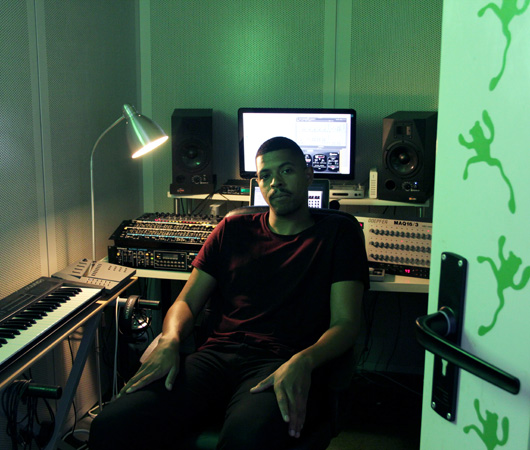
Lando Kal (a.k.a. Antaeus Roy) has made a lot of pit stops over the course of his career, but only seems to be getting better with each new city he calls home. After first gaining notoriety in his hometown of San Francisco as one half of Lazer Sword, Lando relocated to New York for a spell, and followed that up with a move to Berlin. He’s found a home in the German capital, making music inside a space-age studio cabin that’s the envy of just about every producer who sees it. Interested in taking a look at this contraption ourselves, we paid Lando a visit and got him talking about his favorite gear, the evolution of his production methods over the years, and his forthcoming solo LP.
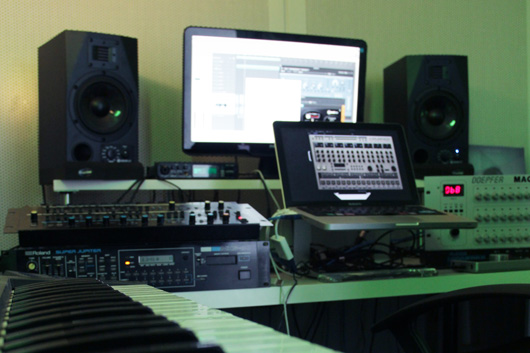
XLR8R: When did you start making music and what was your initial set-up like?
Lando Kal: I’ve been doing it for a good 10 years now. Right out of high school, I just immediately got into it. Actually, if we go way, way back, I used to use that Playstation 2 game, MTV Music Generator. It’s funny, because I talked to [Machinedrum] about this before, and he used it, too. It was the worst way [to produce], but it was also cool because you could actually sample CDs that you put in the Playstation 2, and add these crappy drums over them. I [remember sampling] some old Astrud Gilberto bossa-nova album; I looped almost the full chorus and just put some extra drums over it.
But when I officially had somewhat of a set-up, I used an SP-12 E-mu sampler. I had one turntable and I also used Acid software and Reason. Between all of that, I was pretty much making fully sample-based material.
Were you making music alone before Lazer Sword came about?
Yes, I definitely was. That’s more or less how Bryant [Rutledge (a.k.a. Low Limit), my partner in Lazer Sword,] and I clicked. He had a similar music-making technique and we had similar interests in terms of the music we were making at the time. But yeah, it was definitely before [Lazer Sword that I started making music.] I’d say it was a good four years before we even met.
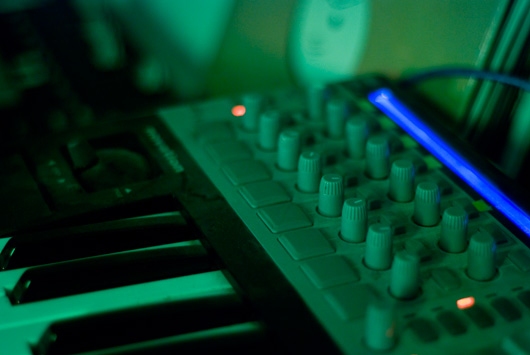
When you two finally did meet, it seems like Lazer Sword became a live act pretty quickly. How did you do the live show?
Initially, we didn’t know what we were doing. We just wanted to have as many things on the table as possible, which proved to be the worst-case scenario. We basically tried to move what we had in our studio to the club. It was kind of a disaster. Timing was always off. We had a MicroKorg, an SP-303, a couple of other samplers, and a backing track in Ableton. We jumped into it pretty quick, because we had a live sense of producing at the time, sampling things and putting in quick melodies on the fly. We also knew certain promoter friends around San Francisco that were up for having us, so we just went in, basically.
At what point did you start differentiating gear for the studio and the club?
I think it was more or less [a result of] figuring out an easier process of playing live, something that was a bit more streamlined and easier for travel, but was still a very live, improvised form of playing. Naturally, we kept a lot of the extra outboard analog gear back at home, and we integrated MIDI controllers to where—even though it was fully digital at that point—we were still able to press loops on the fly and add things in. Every set was still different from the next, or the one before.
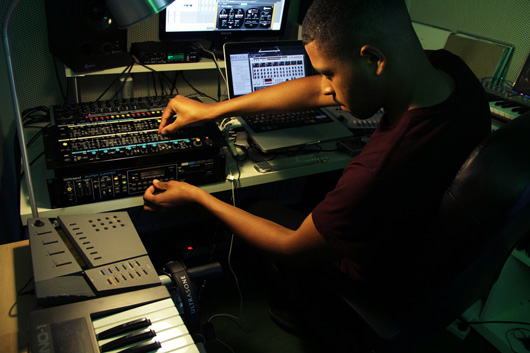
While you guys were both in San Francisco, did you have a joint studio?
For a while, I wasn’t actually living with Bryant yet, but he had such a big room that I just kept all of my music gear in there. So we did have a joint studio for the first year, maybe two years. Then I actually moved in, and I had acquired a bit more things over that year, and I moved into a different room; so then, we had separate studios.
Eventually, you moved to New York. Is that when you really started digging into solo production again?
[In terms of] when I really got into the idea of putting out [solo productions], and got confident with it more, I think New York is what did it. Obviously, I was far away, and we weren’t always going to be collaborating that often with the Lazer Sword stuff, so I finally started getting in the mode of playing out solo more, and producing a lot of solo stuff, and getting confident enough to send it out to other people and put the feelers out.
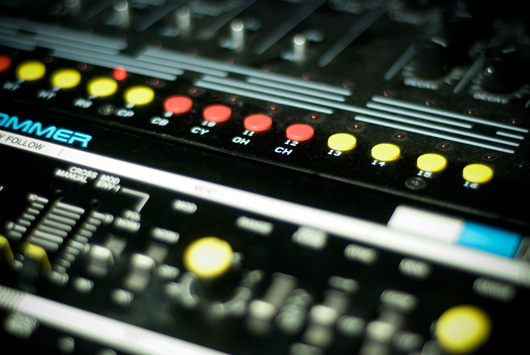
What was your setup like at that time?
I had a Juno-106 synth and a Roland 606 drum machine. I was still using more software than hardware, but I tried to incorporate the outboard gear that I had as much as possible. That started semi-shaping my sound, and it helped me find my identity with the music I was making at the time. But it was pretty minimal; I had a couple of effects processors, a couple of drum machines, the 106, and this Yamaha TQ5, a weird, answering-machine-looking synth that I’ve had for a bit.
Were you still on Ableton at that point?
That was also weird, because I had switched to Logic, just because I was looking for something new. I figured getting new software and learning it would kind of push me in a different direction. Throughout my production career, Ableton is the software I’ve used the most, but Logic I’m just a bit more attached to. I still use Logic now.
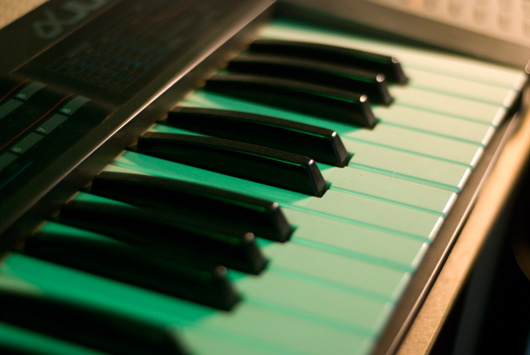
When did the move to Berlin happen?
Two years ago.
Now you have this studio cabin, how did you get it?
Some friends I’ve grown to know through my wife Lynn, who’s Dutch and from Amsterdam, they used to do a lot of these live-production gigs. There would be a crowd, and a group of producers would be working on the same stems that were given to everyone. They’d work on these tracks, and it was a live situation, but they would invite certain MCs. And that was the thing, the guest MCs were pretty big names. They had EPMD, they had Ghostface Killah. Basically, the producers would finish these beats within the two-hour limit that they had, and then they would have these MCs go into the sound cabin to record over these beats. So it was a full-on, live kind of thing.
They were doing that for quite some time, but after those shows were over, the sound cabin was just in storage for a long time. So I asked my friend what he was doing with it, and he was like, “I have to pay so much for storage, if you can get a van and drive the studio from Amsterdam to Berlin, you can have it for free.” So I did that, and it comes in one-meter panels, and I just brought it into the house and built it up in my guest room. [Editor’s Note: Since the time of this interview, the cabin has been moved into a different studio space.]
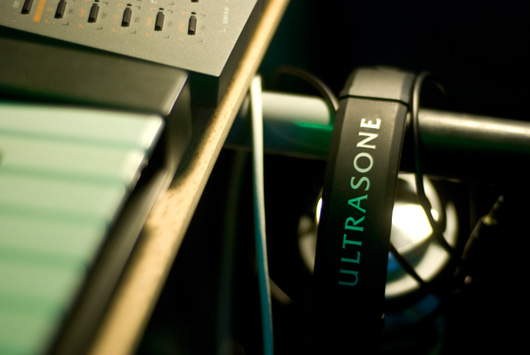
Did you actually do the driving yourself?
No, Lynn actually did all the driving.[laughs] It was hard work [building the studio] though, those panels are heavy as hell! I needed a lot of help with it.
Now that you’ve settled into this space, you’ve acquired even more outboard gear.
Yes. Like I said before, I’m always trying to experiment and just change up my workflow a bit, to change a bit of my inspiration and how I go about working on tunes. I figured trying to go more outside the box was the next step for me. Once I got comfortable with the sound cabin, I just went wild and started buying a lot more outboard gear. Just the whole hands-on feel of producing, I’ve absolutely fallen in love with it, which is why I’ve acquired as much as I have. Over the past couple of years, I’ve picked up more vintage 80’s and 90’s gear, including my Alpha Juno 1, the Yamaha TQ5, and a MKS-80 with the MPG-80 programmer, among other random smaller modules. I’ve also been using a Machinedrum a bit more lately, along with my Acidlab Miami fed through different effects. I’ve mainly just been experimenting with hardware sequencing a lot more.
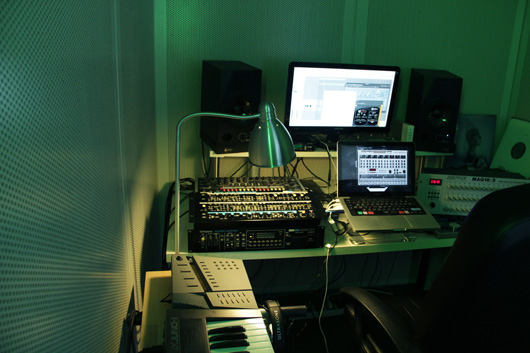
What are your favorite pieces of gear right now?
I have the Super Jupiter, a Roland MKS-80. [I also have] a programmer that was made the same year, the MPG-80, and I use that in pretty much every track lately. It’s amazing. There are so many really cool, quirky sounds and weird atonal bits that you can get from it. That mixed with my Doepfer MAQ 16/3 sequencer, [which I also] use a lot with everything. It’s really fun to just sequence sounds live with it. There are just so many different options and weird directions you can go with the sequence. That’s a nice toy of mine.
How has being in Berlin affected your production approach?
Obviously, you’re surrounded by music everywhere. It’s primarily different mutations of house and techno, and I naturally started getting into more house, and going back to a lot of classic sounds with a soulful, Detroit flair to them. I’ve always loved that [sound], so I just kind of tried it out on my own, to somehow capture my own identity with that style, but still stay in the same vein. Living in Berlin, obviously [that kind of music] is accepted here. I get to play out more often. When it comes to the music I’ve been working on lately, it just connects a bit more.
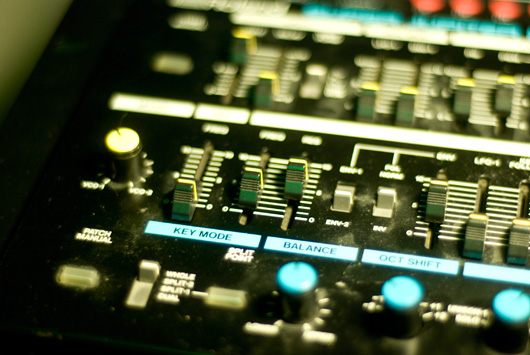
These days, is your production process almost entirely analog?
If I do sample anything, it will be vocal things, or something that has to do with vocals or other weird sorts of found sounds. With the analog gear that I have, I can’t do things that are atmospheric. [If I want to put in some] weird, bloopy, computer, glitchy things here and there, [or] if I want to add some effects to fill in the blanks, that’s when I’ll sample. But for the most part, it’s fully analog.
Even the drum machines?
I have analog drum machines, but I do actually have software versions of the 909. I use the Drumazon a lot. So, in a sense, I do sample drums. But I try and take the drum machines I have and just tweak them a lot. I morph them into different sounds, to where you wouldn’t necessarily notice that it’s an 808 or 606 hi-hats or something.
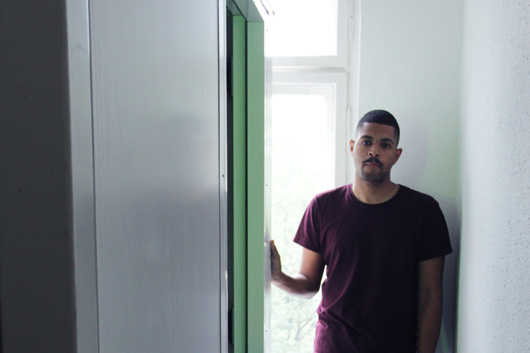
Where do you see your solo music heading?
I feel like it’s getting even more experimental. This album I’m working on, it’s more or less just a lot of composition, and not necessarily all drums. It’s been getting a lot moodier. The music is a bit deeper, and definitely has more of a warehouse vibe. It’s definitely more repetitive than previous releases I’ve done, which tended to be more detailed and choppy, with a lot of things going on. I’m trying to create a bit more space. But it is getting moodier; [I’m making] stuff that could probably work more in a really late-night environment, whether it fits into a techno or house line-up or anything in between.
So you’re definitely going to put out an artist album as Lando Kal.
Yeah, I’ve been really adamant about it lately. I’ve finally gotten a little time off from touring, and I’ve acquired some new gear that I’ve been experimenting with and liking the results. So I just want to make that a big part of an album. I don’t want to rush it. [The release date] is still up in the air, but it’s definitely going to happen.

